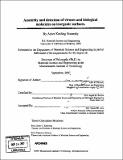Assembly and detection of viruses and biological molecules on inorganic surfaces
Author(s)
Sinensky, Asher Keeling
DownloadFull printable version (44.93Mb)
Other Contributors
Massachusetts Institute of Technology. Dept. of Materials Science and Engineering.
Advisor
Angela M. Belcher.
Terms of use
Metadata
Show full item recordAbstract
This work is composed of three distinct, albeit related, projects. Each project is an exploration of the ways in which interactions between inorganic surfaces and biological molecules can be advantageously exploited. The first project entitled, Biomolecular Recognition of Crystal Defects extended the phage display technique to the detection of crystal defects. The system used is based on the M13 bacteriophage with 7-residue constrained random sequence on protein III. After considerable experimentation a procedure described as 'Diffuse Selection' was developed for selecting defects on crystal surfaces. Challenges occur because it is difficult to drive phage display towards the selection of particular surface features as opposed to whole surfaces. After multiple iterations, diffuse selection was optimized and consensus sequences were achieved. Virus binding was characterized using Atomic Force Microscopy, Fluorescene Microscopy and Titration. Using a simple bimolecular model, the binding sequence identified through this work is shown to have a binding constant 100,000 times better than a random peptide sequence. The second project entitled, Surface Patterning of Genetically Programmed Viruses, developed a generalizable approach to patterning viruses regardless of the genetic modification made to the virus. Genetic modifications are made in order to create viruses which will construct inorganic materials on their bodies in the appropriate chemical environment. Three generalizable virus patterning approaches were developed based on hydrophobic, electrostatic and covalent binding approaches respectively. This work showed successful patterning using all three approaches, but only the covalent approach was shown to be an effective way to actually construct materials on the genetically programmed viruses. (cont.) The third and final project is entitled, A Kelvin Probe Biosensor. This project devised a label-free high-resolution scanning probe approach for detecting target biomolecules on nano-scaled features. In analogy to modern fluorescence microarrays, biological probes were patterned on a gold substrate. When the probes were exposed to a target analyte, the target would bind the probe and change the local surface potential. This change in surface potential could then be measured using Kelvin Probe Force Microscopy. This work represented the first example of detecting biological molecules on surface using KPFM at the nanoscale.
Description
Thesis (Ph. D.)--Massachusetts Institute of Technology, Dept. of Materials Science and Engineering, 2007. Includes bibliographical references.
Date issued
2007Department
Massachusetts Institute of Technology. Department of Materials Science and EngineeringPublisher
Massachusetts Institute of Technology
Keywords
Materials Science and Engineering.